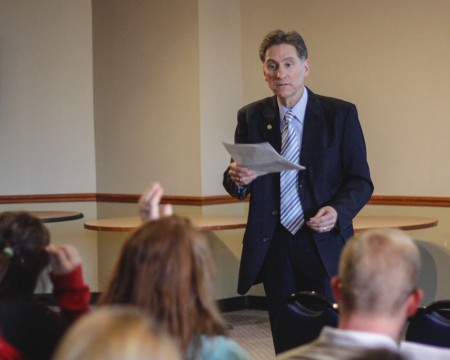
Following a semester and a half of financial evaluations, the University’s budget planning and review teams have submitted their final reports to the President’s Office.
The BPR teams were originally charged with the task of finding a way to cut expenditures by $2.3 million in an effort to make up a state-made deficit to the University budget.
On Monday afternoon, President Randy Dunn presented the proposed budget cuts to Faculty Senate. Each member received a copy of the document and were allowed to ask Dunn questions regarding concerns they had.
As a result, Faculty Senate passed a resolution expressing appreciation toward the President and his promotion of shared governance through the budget review process.
The group, however, did not pass the resolution concerning compliance with the University policy and the protection of academic programs in the president’s budget planning review process.
On Tuesday afternoon, Dunn visited two more constituency groups, Staff Congress and Student Government Association.
Dunn allowed for debate on the recommendations, which were divided into categories of nonacademic and academic.
Prior to constituent meetings on Feb. 25, Dunn and Chief of Staff Josh Jacobs began collapsing the report and identifying priority recommendations.
Following the condensing process, the vice presidents met with Dunn and Jacobs to make suggestions and decide which parts of the list needed expansion or more background information prior to final submission.
The six-page draft could change before the Board of Regents sees it after Dunn visits other constituencies on campus.
Dunn said if all of the recommendations form the working draft made it past the Board of Regents, then approximately $6.2 million could be generated through savings to the University’s operating budget in the coming fiscal year.
Two open forums will be held at 9 a.m. and 2 p.m. on Tuesday in the Barkley Room, located on the third floor of the Curris Center.
Steve White, assistant professor of biology, said many of the items listed as nonacademic items in the long-run effect academics.
“Cutting and reducing some housing scholarships was marked nonacademic,” White said.
He said if that means a student does not attend Murray State then that has an academic impact by cutting out a student who would otherwise be paying tuition.
Bonnie Higginson, vice president of Academic Affairs, said budget cuts were never a pleasant item for a University to consider, but her impression is that at this point there seems to be a general balance.
“Some items might generate a lot of discussion,” she said. “There are going to be things that students, faculty and staff wont like, but it is not as bad as what most people feared.”
The University’s administrative council met Tuesday morning, prior to constituent meetings, so Dunn could lead the group step-by-step through the condensed BPR report.
Higginson said the administrative council was created at the beginning of Dunn’s presidency and is composed of the vice presidents and prominent leaders who represent different aspects of the University. She said the deans of each academic college were also at the council meeting Tuesday morning.
“The allocated time for the meeting was two hours,” she said. “While the group was thorough in its discussion of the recommendations, we did not extend beyond our allocated time.”
Higginson said reactions were mixed, but the constituents understand the University had to find ways to save money.
“As far as the items that are academic, particularly as they relate to the academic colleges, the cuts are not terribly significant and should not impact students largely,” she said. “However, there are some additional items that are fairly large in dollar savings that could have a negative impact on the academic side of the University.”
Story by Meghann Anderson, News Editor, and Chris Wilcox, Chief Copy Editor.